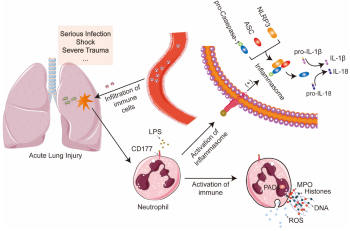The link between neutrophils, NETs, and NLRP3 inflammasomes: The dual effect of CD177 and its therapeutic potential in acute respiratory distress syndrome/acute lung injury
DOI:
https://doi.org/10.17305/bb.2023.10101Keywords:
Acute respiratory distress syndrome (ARDS), CD177, NLRP3, neutrophil extracellular traps (NETs), reactive oxygen species (ROS)Abstract
Neutrophils are important inflammatory effector cells that protect against foreign invasion but also cause self-harm. Numerous neutrophils infiltrate the lungs in acute respiratory distress syndrome/acute lung injury (ARDS/ALI) patients. However, the exact impact of neutrophil infiltration on ARDS’s onset and progression remains unclear. To investigate this, we analyzed two ARDS-related datasets from the Gene Expression Omnibus public database and discovered an association between CD177, a neutrophil-specific surface protein, and ARDS progression. We used quantitative flow cytometry to assess CD177+ neutrophils in the peripheral blood of clinical ARDS patients vs healthy controls, finding a significant increase in CD177+ neutrophils percentage among total neutrophils in ARDS patients. This finding was further confirmed in ALI mouse models. Subsequent animal experiments showed that anti-CD177 effectively reduces pulmonary edema, neutrophil infiltration, and inflammatory cytokine release, along with a decrease in reactive oxygen species (ROS) and myeloperoxidase (MPO) levels. We also established an in vitro co-culture system to mimic neutrophil and lung epithelial cell interactions. In the anti-CD177 group, we observed decreased expression of NLRP3, caspase 1, peptidyl arginine deiminase (PAD4), MPO, and ROS, along with a reduction in certain inflammatory cytokines. These results indicate a crucial role for the CD177 gene in ARDS’s development and progression. Inhibiting CD177 may help mitigate excessive activation of NLRP3 inflammasomes, ROS, and neutrophil extracellular traps (NETs), thus alleviating ARDS.
Citations
Downloads

Downloads
Published
Data Availability Statement
The data that supports the findings of this study are available upon a reasonable request from the corresponding and first authors.
Issue
Section
Categories
License
Copyright (c) 2024 Jingying li, Zhansheng Fang, Shumin Xu, Haiwei Rao, Junzhe Liu, Kunjian Lei, Lufei Yang, Chong Wang, Zhenguo Zeng

This work is licensed under a Creative Commons Attribution 4.0 International License.
How to Cite
Accepted 2024-01-01
Published 2024-01-13









